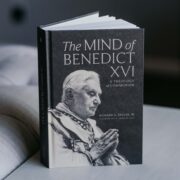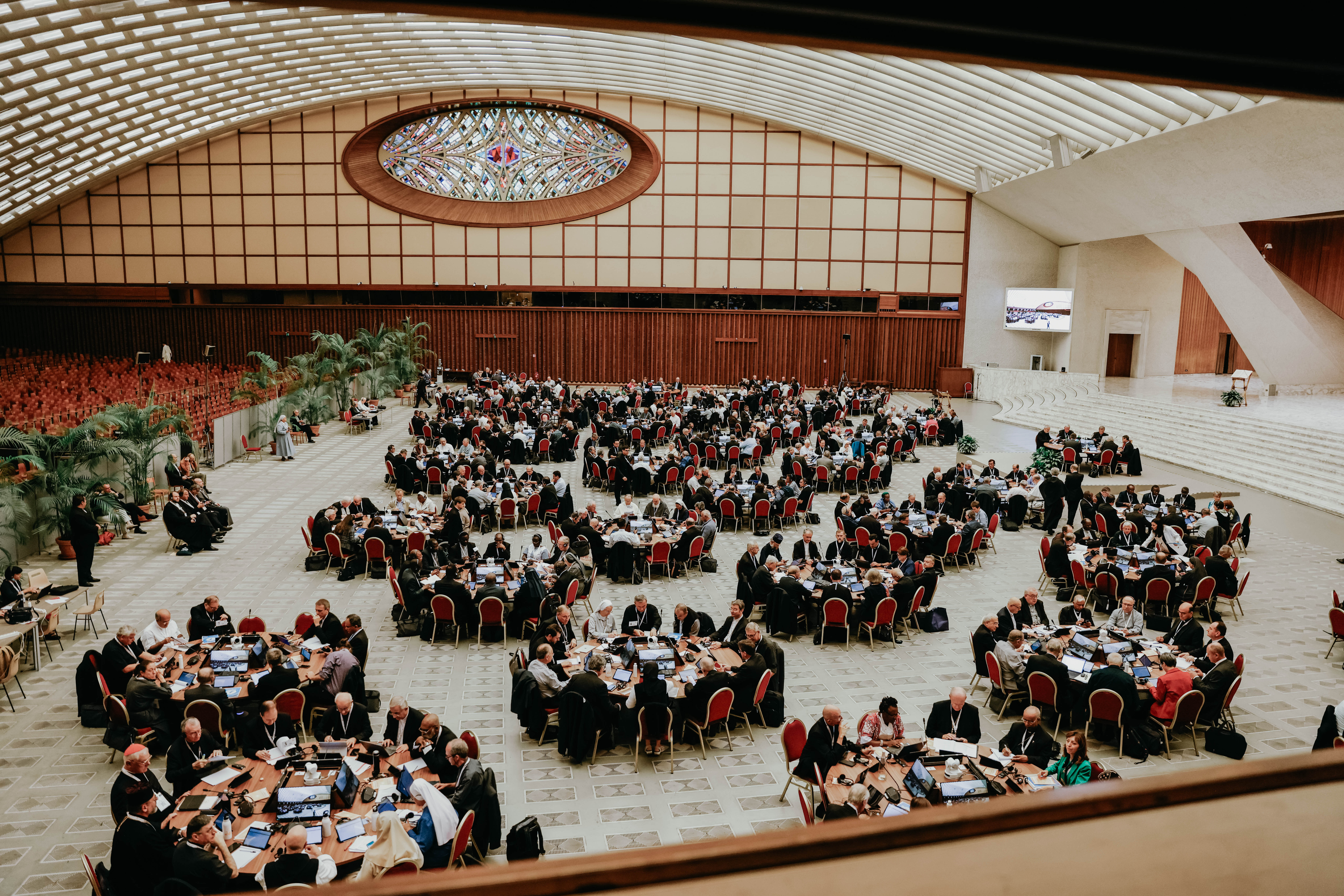The General Assembly of the Synod of Bishops “For a Synodal Church: Communion, Participation, and Mission” is underway. Its work is divided into five modules. The first four modules pertain to sections A, B1, B2, and B3 of the Instrumentum Laboris. Module 1, “For a Synodal Church: An Integral Experience” (A), was the topic for sessions on October 4–7. From October 9–21, the topics for modules 2–3 were and are “Communion” (B1), “Mission” (B2), and “Participation” (B3). The fifth and final module (Oct. 23–28)1 will “be devoted to the discussion and approval of the synthesis report, which we will then hand over to the Holy Father,”2 reports Cardinal Hollerich, the relator general for the synod.
Prayer has been a major component of this synod. The General Assembly was preceded by a three-day spiritual retreat. Additionally, the synod’s meetings begin with morning prayer each day around 8:45 a.m., and there are times for prayer during the small group discussions as well. One of the lay participants, José Manuel De Urquidi, estimates about two hours of prayer per day during the synod’s work.3 As Hannah Brockhaus reports, “Both Pope Francis and Cardinal Mario Grech, secretary general of the Synod of Bishops, have emphasized the importance of prayer in the synodal process.”4
The synod’s work will take place through both general assemblies with everyone together and small group work, dubbed circuli minores (small circles). The precise procedure for this work has come under criticism, because not all of the members will be discussing all of the issues during the small group sessions. Rather, various subtopics—including the most controversial ones (e.g., LGBTQ+ and women’s ordination to the diaconate)—are only assigned to specific small groups. The participants’ small group assignments were connected to what each member indicated as their top priorities for the synod, which may seem fair, but it is also causing some concern. The members most likely to have chosen a controversial topic as the most important for the synod would most likely be the members who would also advocate for the Church to change her stance on those issues. Furthermore, only the small group participants are allowed to draft and vote on the reports about the discussion of those issues, thus potentially skewing the results, as Jonathan Liedl has speculated.5
For now, as spectators, all we can really do is wait and pray.
Nevertheless, there will be an opportunity for members that are not part of a particular small group to intervene and offer feedback regarding the small group discussions when each working group presents their initial summary in plenary session. It is only after the plenary session with such interventions that the small groups will go back and formulate their final reports, including proposals for the next steps.6
Paolo Ruffini, the prefect of the Dicastery for Communications, has tried to downplay concerns about conflict on hot-button issues. He said that “so far there has been no element that may be defined as ‘polarization,’ we are just sharing experiences and concerns that may be different.”7 Yet Ruffini himself has also stated all of the following: (1) some participants have asked “for greater discernment on the teaching of the Church on the subject of sexuality,”8 (2) “others ‘said there’s no need for this further discernment,”9 and (3) some “highlighted the need to remain within the Magisterium of the Church.”10 These certainly appear to be polar opposite views.
For his part, Gérald Cyprien Cardinal Lacroix (Quebec) has reiterated that “the object of the synod . . . is not to address doctrinal aspects” and that “we mustn’t expect changes at a doctrinal level, this is not a doctrinal synod.”11 The fact that some members are calling for greater discernment regarding Church teaching suggests otherwise, however. Doctrine may not supposed to be the object of the synod, but de facto, it certainly seems to be under discussion.

Precisely what is being discussed and by whom might be harder to determine, however. As John L. Allen, Jr. relates, “The synod is an event which, in the past, unfolded with at least some degree of openness, but this time it’s laboring under tight new confidentiality requirements, including barring participants from revealing even their own contributions to the discussions.”12 Nevertheless, I say might be harder to determine because—as with other officials’ statements about this synod—contradictions abound. On the one hand, reports The Pillar, “Synod organizers have insisted on tight confidentiality around the process. Participants are not allowed to give interviews unless expressly authorized by the organizing team, and all the press are to be told is what the official synodal communications team choose to relate to the official press conferences. And the rules for the assembly make it explicit that attendees cannot discuss what was said or by whom, even after the synod ends.”13 On the other hand, reports Elise Ann Allen, “Vatican officials have said that engagement with the press is a personal decision, and participants who choose to give interviews will not be ‘punished,’” and “Paolo Ruffini . . . told journalists that papal indications notwithstanding, ‘Every member of the synod makes their own discernment’ in terms of whether to speak with the media.”14 Additionally, the synod was not going to release information about which members were involved in which small groups and their corresponding topics of discussion. Yet, as The Pillar reports, confidential working documents—including working group membership information—“were posted to an unsecured cloud server,”15 to which media outlets gained access.
So far, then, there is not much clarity about how the synod is shaping up. There are conflicting statements about the level of secrecy and even about the level of conflict within the synod itself. For now, as spectators, all we can really do is wait and pray.
You can read part 5 here, part 4 here, part 3 here, part 2 here, and part 1 here.
1 For visual and textual explanations of the sessions, see XVI General Assembly of the Synod of Bishops, “Methodology for the Working Groups According to the Regulations of the Assembly” (Oct. 5, 2023), available here.
2 Jean-Claude Cardinal Hollerich, “Relazione introduttiva,” XVI General Assembly of the Synod of Bishops (Oct. 4, 2023).
3 See Jonathan Liedl, “Listening and Learning: Synod on Synodality Delegate Is Relishing His Participation,” National Catholic Register (Oct. 12, 2023), available here.
4 Hannah Brockhaus/CNA, “Prayer Opportunities Abound at Synod on Synodality,” National Catholic Register (Oct. 11, 2023).
5 See Jonathan Liedl, “Synod on Synodalty’s New Methodology Could Skew Reports on Controversial Issues,” National Catholic Register (Oct. 11, 2023).
6 See the page entitled “The Dynamics of Each Segment” in “Methodology for the Working Groups.”
7 Quoted from Elise Ann Allen, “Synod participants claim ‘no polarization’ on women, LGBTQ+ issues,” Crux (Oct. 12, 2023), available here.
8 Quoted from Jonathan Liedl/CNA, “Synod on Synodality Members Ask ‘for Greater Discernment’ of Church Teaching on Sexuality,” National Catholic Register (Oct. 11, 2023), available here.
9 Ibid.
10 Quoted from Elise Ann Allen, “Synod participants.”
11 Ibid.
12 John L. Allen, Jr., “Synod Files: Of Open Windows and Closed Doors, plus the Hard Math of Priest Shortages,” Crux (Oct. 8, 2023).
13 Ed. Condon, “‘Normal’ hatred, synodal ‘secrecy’, and ‘original language,’” The Pillar (Oct. 13, 2023).
14 Elise Ann Allen, “Synod members won’t be punished for giving interviews, official says,” Crux (Oct. 6, 2023).
15 “Vatican comms chief ‘clarifies’ unsecured synod file server,” The Pillar (Oct. 16, 2023).
